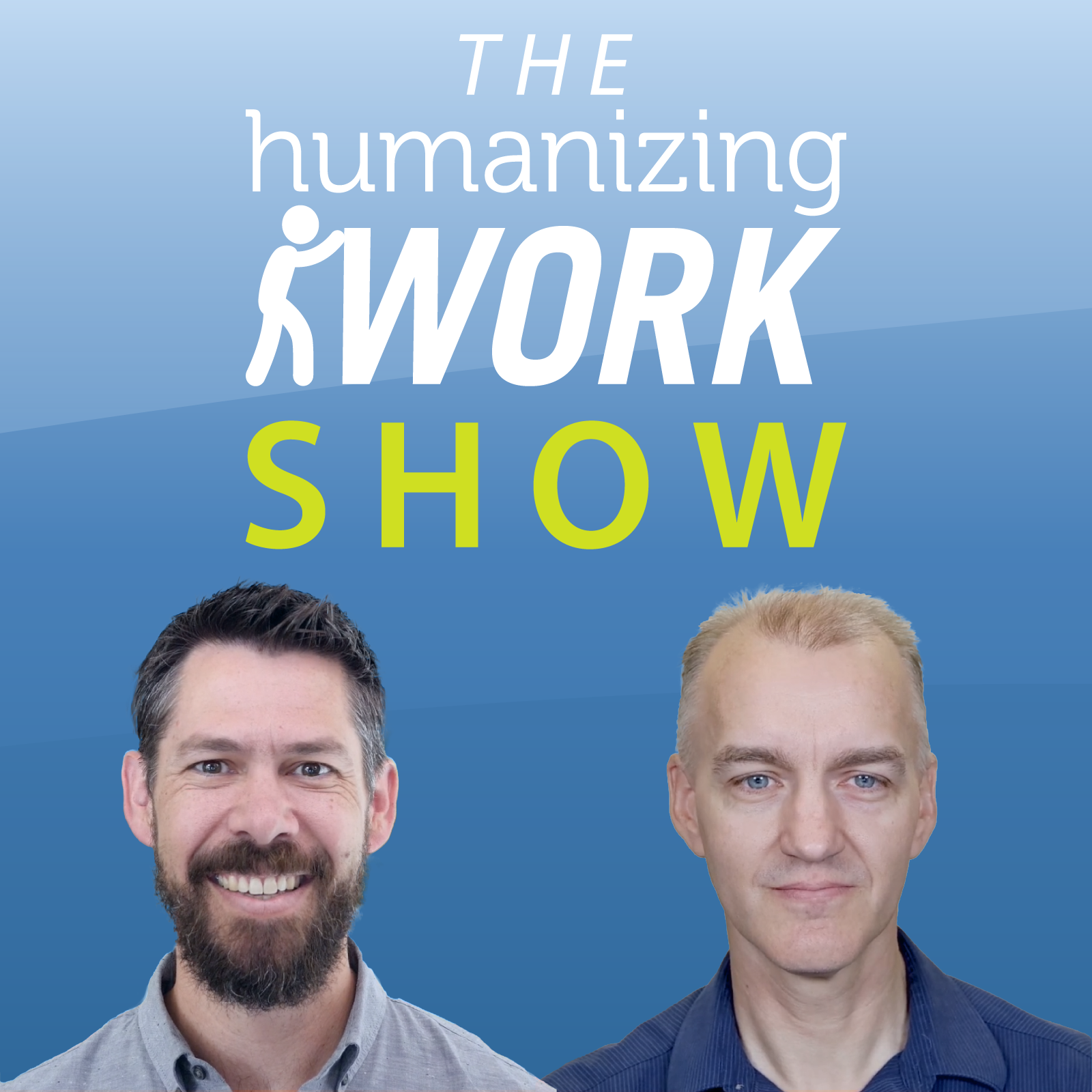Episode Transcript
1
00:00:06,533 --> 00:00:08,366
Welcome
to the Humanizing Work Show.
2
00:00:08,366 --> 00:00:09,466
I'm Peter Green.
3
00:00:09,466 --> 00:00:11,566
Richard Lawrence
is in Dallas presenting
4
00:00:11,566 --> 00:00:13,600
at the Agile
2024 conference.
5
00:00:13,866 --> 00:00:16,600
So I'm solo today
talking about how leadership
6
00:00:16,600 --> 00:00:18,133
communication goes wrong
7
00:00:18,133 --> 00:00:20,133
and three strategies
to improve it.
8
00:00:20,733 --> 00:00:23,233
I was recently working
as an executive coach
9
00:00:23,233 --> 00:00:24,300
with a CEO
who had a big development
10
00:00:24,300 --> 00:00:25,533
with a CEO
who had a big development
11
00:00:25,533 --> 00:00:27,533
goal of being less assertive
12
00:00:27,600 --> 00:00:29,800
and more inquisitive
with her staff.
13
00:00:30,866 --> 00:00:32,400
A month
or two into the engagement,
14
00:00:32,400 --> 00:00:33,733
she invited me to sit in
15
00:00:33,733 --> 00:00:35,833
on her team's
quarterly business review,
16
00:00:35,833 --> 00:00:39,100
the QBR as an observer
to see what I noticed.
17
00:00:39,900 --> 00:00:40,666
The meeting
18
00:00:40,666 --> 00:00:43,833
covered a lot of ground,
reviewing major initiatives,
19
00:00:43,833 --> 00:00:46,766
OKRs and health metrics
on how the company was doing
20
00:00:47,433 --> 00:00:48,933
as they moved
through the agenda.
21
00:00:48,933 --> 00:00:49,566
There were several
22
00:00:49,566 --> 00:00:51,333
discussions
about performance,
23
00:00:51,333 --> 00:00:53,733
suggestions
for improvement, and debates
24
00:00:53,733 --> 00:00:55,733
about what
should change going forward.
25
00:00:56,200 --> 00:00:58,700
I could see the CEO really
doing her homework,
26
00:00:58,766 --> 00:01:01,733
waiting for others to speak
first, reformulating
27
00:01:01,733 --> 00:01:02,466
opinions as curiosity
driven questions
28
00:01:02,566 --> 00:01:04,200
opinions as curiosity
driven questions
29
00:01:04,733 --> 00:01:07,200
and as the team finished
the last agenda item,
30
00:01:07,200 --> 00:01:09,166
the CEO asked
if there was anything
31
00:01:09,166 --> 00:01:10,333
that was unclear
32
00:01:10,333 --> 00:01:12,333
that they should align on
before they wrapped
33
00:01:13,000 --> 00:01:14,233
the team having been at it
34
00:01:14,233 --> 00:01:16,700
all morning, generally
looked a bit toasty.
35
00:01:16,700 --> 00:01:19,100
They were ready for
lunch and nobody spoke up
36
00:01:20,300 --> 00:01:21,266
during lunch.
37
00:01:21,266 --> 00:01:22,233
the CEO
38
00:01:22,233 --> 00:01:24,800
pulled me aside and asked me
for any quick impressions.
39
00:01:25,400 --> 00:01:28,433
I complimented her on her
clear improvements and cited
40
00:01:28,433 --> 00:01:30,600
a few specific examples
that stood out to me.
41
00:01:31,333 --> 00:01:33,600
Then I asked her
what her goal was for,
42
00:01:33,600 --> 00:01:34,833
how she concluded
the meeting
43
00:01:34,833 --> 00:01:36,366
with that question,
and about anything
44
00:01:36,366 --> 00:01:38,366
they needed to align on.
45
00:01:38,533 --> 00:01:41,600
She shared that in the past,
people would leave the QBR
46
00:01:41,600 --> 00:01:43,800
with different opinions
or takeaways.
47
00:01:44,500 --> 00:01:47,000
There was even one train
wreck example she shared,
48
00:01:47,433 --> 00:01:48,566
where they had discussed
49
00:01:48,566 --> 00:01:50,566
what to do about a project
that was in trouble,
50
00:01:50,966 --> 00:01:52,766
and they talked about three
options:
51
00:01:52,766 --> 00:01:56,166
move the deadline back,
get some help from a vendor,
52
00:01:56,400 --> 00:01:58,566
and I think, renegotiate
the scope
53
00:01:58,566 --> 00:02:00,566
with the customer
of that project.
54
00:02:01,133 --> 00:02:03,300
She described how then,
after the meeting,
55
00:02:03,333 --> 00:02:06,066
different versions of all
three of those options
56
00:02:06,266 --> 00:02:07,166
somehow made it
57
00:02:07,166 --> 00:02:09,166
into the rumor
mill of the organization,
58
00:02:09,333 --> 00:02:10,933
and things
had blown up a bit
59
00:02:10,933 --> 00:02:12,933
until they spent the time
to clean it up.
60
00:02:13,566 --> 00:02:15,566
So she wanted to make sure
they were aligned.
61
00:02:16,466 --> 00:02:19,466
I told her I had some advice
about a more effective way
62
00:02:19,466 --> 00:02:20,000
to do that
63
00:02:20,000 --> 00:02:22,033
in future meetings,
and that's the advice
64
00:02:22,033 --> 00:02:23,833
we're going to share
in today's episode.
65
00:02:23,833 --> 00:02:24,966
But first,
66
00:02:24,966 --> 00:02:27,600
the humanizing work Show
is a free resource sponsored
67
00:02:27,600 --> 00:02:29,600
by the Humanizing Work
Company.
68
00:02:29,600 --> 00:02:31,866
Humanizing work exists
to make work more fit
69
00:02:31,866 --> 00:02:33,266
for humans and humans,
70
00:02:33,266 --> 00:02:35,266
more capable
of doing great work.
71
00:02:35,566 --> 00:02:37,600
To that end,
we do training and coaching
72
00:02:37,600 --> 00:02:38,600
in three areas.
73
00:02:38,600 --> 00:02:40,433
First, we help leaders
lead empowered
74
00:02:40,433 --> 00:02:42,433
teams and individuals
more effectively.
75
00:02:42,866 --> 00:02:45,366
Second, we help product
people turn their ideas
76
00:02:45,366 --> 00:02:48,033
into good visions,
experiments, and backlogs.
77
00:02:48,566 --> 00:02:50,466
And third,
we help teams collaborate
78
00:02:50,466 --> 00:02:53,266
better to produce meaningful
outcomes on complex work.
79
00:02:53,900 --> 00:02:55,966
If you or your organization
would benefit
80
00:02:55,966 --> 00:02:58,333
from better leadership,
better product management,
81
00:02:58,600 --> 00:03:01,000
or better collaboration
and who wouldn't?
82
00:03:01,566 --> 00:03:03,266
And if you find our vision
for human
83
00:03:03,266 --> 00:03:05,066
centric work
compelling, visit
84
00:03:05,066 --> 00:03:06,700
the contact page on
Humanizing Work.
85
00:03:06,700 --> 00:03:08,900
Dot com and schedule
a conversation with us.
86
00:03:10,200 --> 00:03:10,700
Okay.
87
00:03:10,700 --> 00:03:11,566
To prevent that
88
00:03:11,566 --> 00:03:14,466
kind of misalignment
that that CEO experienced,
89
00:03:14,766 --> 00:03:17,533
there are three strategies
leadership teams should do
90
00:03:17,533 --> 00:03:19,766
in order to cascade
communication well.
91
00:03:20,533 --> 00:03:21,900
Strategy One:
92
00:03:21,900 --> 00:03:23,700
Align and Assign
93
00:03:23,700 --> 00:03:25,700
happens
in the meeting itself.
94
00:03:25,866 --> 00:03:27,266
Strategy Two:
95
00:03:27,266 --> 00:03:30,666
Communicate and Listen
is a specific structure
96
00:03:30,666 --> 00:03:32,666
for cascading
the communication down.
97
00:03:33,066 --> 00:03:35,633
And strategy
Three: Return and Report
98
00:03:35,666 --> 00:03:38,166
is about closing the loop
on that communication.
99
00:03:39,133 --> 00:03:41,900
Starting then with strategy
one align and assign.
100
00:03:42,266 --> 00:03:43,900
This is one of the more
important parts
101
00:03:43,900 --> 00:03:45,733
of any leadership meeting.
102
00:03:45,733 --> 00:03:46,133
In fact,
103
00:03:46,133 --> 00:03:49,166
I advise all of my clients
to conclude every team
104
00:03:49,166 --> 00:03:52,166
meeting with 5 to 10 minutes
to get clear on
105
00:03:52,166 --> 00:03:54,566
who will communicate
what to whom and by when.
106
00:03:55,266 --> 00:03:57,666
It's not enough to make
decisions in these meetings,
107
00:03:57,866 --> 00:04:00,666
you have to overcommunicate
those decisions for them
108
00:04:00,666 --> 00:04:02,000
to make their way
into the collective
109
00:04:02,000 --> 00:04:03,666
consciousness
of the organization.
110
00:04:04,800 --> 00:04:05,100
If you've
111
00:04:05,100 --> 00:04:07,100
made a decision
and you want it to stick,
112
00:04:07,133 --> 00:04:08,366
you need to be able
to answer
113
00:04:08,366 --> 00:04:10,900
five specific questions
about that decision.
114
00:04:11,766 --> 00:04:13,466
First, what problem
115
00:04:13,466 --> 00:04:15,166
are you solving
with this decision
116
00:04:15,166 --> 00:04:17,166
and why is the problem
important?
117
00:04:17,600 --> 00:04:19,800
As much as Simon Sinek book,
start with why
118
00:04:19,866 --> 00:04:21,966
probably could have been
a long blog post.
119
00:04:22,233 --> 00:04:24,233
The core idea is super
solid.
120
00:04:24,266 --> 00:04:24,933
Start with
121
00:04:24,933 --> 00:04:27,066
why you're doing
whatever it is you're doing.
122
00:04:28,100 --> 00:04:30,566
Second,
what is the solution?
123
00:04:31,266 --> 00:04:33,233
This is what you've probably
spent the most time
124
00:04:33,233 --> 00:04:35,600
on in the meeting,
so capture those details.
125
00:04:36,566 --> 00:04:39,600
Third, every decision
you make has side effects,
126
00:04:39,833 --> 00:04:41,733
and it's good
to capture the side effects
127
00:04:41,733 --> 00:04:44,433
you've thought about and how
you plan to address them.
128
00:04:45,533 --> 00:04:48,000
Next, the fourth question
what obstacles
129
00:04:48,000 --> 00:04:50,166
do you anticipate
in implementing the change?
130
00:04:50,933 --> 00:04:53,200
Obstacles are different
from side effects,
131
00:04:53,200 --> 00:04:55,066
where we assume
we could make the change,
132
00:04:55,066 --> 00:04:57,066
but it'll have downstream
impacts.
133
00:04:57,166 --> 00:04:58,933
The obstacles are about what
134
00:04:58,933 --> 00:05:02,366
time, resources, and focus
will be needed to succeed.
135
00:05:03,366 --> 00:05:03,866
Finally,
136
00:05:03,866 --> 00:05:05,866
the fifth
question is to answer.
137
00:05:05,966 --> 00:05:07,166
Who needs to do what
138
00:05:07,166 --> 00:05:09,166
in order
to execute on the decision?
139
00:05:09,633 --> 00:05:11,000
Make sure those people know
140
00:05:11,000 --> 00:05:13,266
they have permission
to do what they need to do,
141
00:05:13,466 --> 00:05:15,666
and that it's prioritized
appropriately.
142
00:05:16,766 --> 00:05:18,566
Ask someone
to capture the answers
143
00:05:18,566 --> 00:05:19,566
to those five questions
144
00:05:19,566 --> 00:05:22,100
as you work through them
problem, solution,
145
00:05:22,100 --> 00:05:24,833
side effects, obstacles,
and collaboration.
146
00:05:25,233 --> 00:05:27,233
Then have them
read it out to the team.
147
00:05:27,600 --> 00:05:29,866
This gives team members
a chance to chime in on
148
00:05:29,866 --> 00:05:31,333
anything
that was overlooked,
149
00:05:31,333 --> 00:05:32,033
or that wasn't
150
00:05:32,033 --> 00:05:33,533
what they expected
to communicate,
151
00:05:33,533 --> 00:05:35,033
and it gives you a chance
to get aligned
152
00:05:35,033 --> 00:05:36,966
on those things.
153
00:05:36,966 --> 00:05:38,166
Then the last thing we check
154
00:05:38,166 --> 00:05:40,733
on is the time frame
for communicating things.
155
00:05:41,200 --> 00:05:43,166
Sometimes it's important
that people hear
156
00:05:43,166 --> 00:05:45,133
about decisions
at the same time.
157
00:05:45,133 --> 00:05:46,866
If team learns of a change
158
00:05:46,866 --> 00:05:49,200
in compensation policy
before team B,
159
00:05:49,766 --> 00:05:51,200
the rumors might hit team B
160
00:05:51,200 --> 00:05:51,766
before the
161
00:05:51,766 --> 00:05:53,766
official communication,
and that's not good.
162
00:05:53,933 --> 00:05:56,900
So agree when people will
share the communication.
163
00:05:57,500 --> 00:05:59,433
Almost always this lands on
164
00:05:59,433 --> 00:06:01,433
something
like within 24 hours,
165
00:06:01,600 --> 00:06:03,333
but sometimes it's
more urgent
166
00:06:03,333 --> 00:06:06,366
or less urgent and it's good
to get aligned on timing.
167
00:06:06,933 --> 00:06:09,566
So that strategy
one align and assign
168
00:06:09,833 --> 00:06:12,033
align on your answers
to the five questions.
169
00:06:12,366 --> 00:06:14,333
Then assign
who will communicate
170
00:06:14,333 --> 00:06:16,400
what to whom and how
at the end of the meeting.
171
00:06:17,833 --> 00:06:19,100
Strategy two
172
00:06:19,100 --> 00:06:19,866
communicate and
173
00:06:19,866 --> 00:06:21,966
Listen is a structure
for how to share
174
00:06:21,966 --> 00:06:23,100
the information aligned on.
175
00:06:23,100 --> 00:06:24,633
In step one.
176
00:06:24,633 --> 00:06:26,633
This structure achieves
two goals.
177
00:06:26,666 --> 00:06:28,566
First,
it helps decision stick
178
00:06:28,566 --> 00:06:29,633
by ensuring that they're
clearly communicated.
179
00:06:29,633 --> 00:06:30,533
by ensuring that they're
clearly communicated.
180
00:06:31,000 --> 00:06:33,466
And second,
it helps surface concerns
181
00:06:33,466 --> 00:06:33,866
The leaders
182
00:06:33,866 --> 00:06:36,200
may not have been aware of
when they made the decision.
183
00:06:37,200 --> 00:06:39,300
This structure, by the way,
is a variation
184
00:06:39,300 --> 00:06:40,433
on the humanizing work
feedback process.
185
00:06:40,433 --> 00:06:41,500
on the humanizing work
feedback process.
186
00:06:41,933 --> 00:06:43,500
If you're unfamiliar
with that pattern,
187
00:06:43,500 --> 00:06:46,166
you can check out
episode 121 to learn more.
188
00:06:46,433 --> 00:06:48,433
We'll drop a link
to that in the show notes,
189
00:06:48,500 --> 00:06:50,966
and we'll share a graphic
for specifically
190
00:06:50,966 --> 00:06:53,233
how to use this process
for communication.
191
00:06:54,266 --> 00:06:56,266
The process has six steps
192
00:06:56,600 --> 00:06:58,733
steps one, two, and six.
193
00:06:58,733 --> 00:07:00,733
The opening two
and the closing one
194
00:07:00,866 --> 00:07:02,866
are about sharing something.
195
00:07:03,000 --> 00:07:04,733
Steps three, four, and five.
196
00:07:04,733 --> 00:07:06,833
The middle steps
are about listening
197
00:07:06,866 --> 00:07:08,866
to specific things.
198
00:07:09,000 --> 00:07:11,366
Step one
is to set the context.
199
00:07:11,766 --> 00:07:12,966
What's the background on
200
00:07:12,966 --> 00:07:14,833
why we're talking about this
today?
201
00:07:14,833 --> 00:07:16,466
The problem that you aligned on
202
00:07:16,466 --> 00:07:18,566
AT the beginning of aLIGN
AND ASsign is
203
00:07:18,566 --> 00:07:20,566
good context for this.
204
00:07:20,833 --> 00:07:22,833
Step two
is the actual content.
205
00:07:22,833 --> 00:07:25,833
Share the decisions
as well as the side effects,
206
00:07:25,866 --> 00:07:27,866
obstacles,
and collaboration,
207
00:07:28,166 --> 00:07:29,333
whatever it is.
208
00:07:29,333 --> 00:07:31,633
Then over to the listening
side.
209
00:07:32,166 --> 00:07:35,166
Step three is for questions,
specifically
210
00:07:35,166 --> 00:07:37,166
clarifying questions
211
00:07:37,266 --> 00:07:38,966
for people
that you've communicated to.
212
00:07:38,966 --> 00:07:40,333
What didn't make sense?
213
00:07:40,333 --> 00:07:42,700
What did you not understand
about the context
214
00:07:42,700 --> 00:07:43,600
or the content?
215
00:07:44,733 --> 00:07:47,233
Then onto
step four, which is kudos.
216
00:07:47,233 --> 00:07:49,833
What do you like about this
decision or this direction?
217
00:07:50,433 --> 00:07:53,133
Now, if you're sharing
bad news, skip this step.
218
00:07:53,166 --> 00:07:54,500
You don't need to ask people
219
00:07:54,500 --> 00:07:56,933
what they liked about
the reduction in force.
220
00:07:56,933 --> 00:07:58,933
That's
just counterproductive.
221
00:07:59,033 --> 00:08:00,566
Otherwise ask it.
222
00:08:00,566 --> 00:08:01,133
It's often
223
00:08:01,133 --> 00:08:03,566
enlightening to hear
what stands out as positive
224
00:08:03,566 --> 00:08:05,566
to different people
on your staff,
225
00:08:05,633 --> 00:08:07,900
and for the people
that might be uncertain
226
00:08:07,900 --> 00:08:09,900
about a decision
or direction.
227
00:08:10,000 --> 00:08:12,633
It's good for them to hear
from the enthusiastic ones
228
00:08:12,633 --> 00:08:13,166
on your team
229
00:08:13,166 --> 00:08:15,266
instead of always coming
directly from you.
230
00:08:16,433 --> 00:08:18,633
Step five is concerns.
231
00:08:19,266 --> 00:08:20,433
What about this decision?
232
00:08:20,433 --> 00:08:22,000
Has you a bit worried?
233
00:08:22,000 --> 00:08:24,666
Focus on listening
and capturing concerns here.
234
00:08:25,000 --> 00:08:26,400
It's not a debate
235
00:08:26,400 --> 00:08:27,433
and you don't need
to immediately address
236
00:08:27,433 --> 00:08:27,600
and you don't need
to immediately address
237
00:08:27,600 --> 00:08:28,700
and you don't need
to immediately address
238
00:08:28,700 --> 00:08:30,100
those concerns
or even commit
239
00:08:30,100 --> 00:08:32,100
to doing it in the future.
240
00:08:32,233 --> 00:08:34,700
If there are some concerns
that are easy to address,
241
00:08:34,700 --> 00:08:36,266
like maybe somebody
misunderstood
242
00:08:36,266 --> 00:08:37,633
something or wasn't
aware of what resources
243
00:08:37,633 --> 00:08:39,266
something or wasn't
aware of what resources
244
00:08:39,266 --> 00:08:40,300
are being made available,
245
00:08:40,300 --> 00:08:42,300
feel free to address them
immediately.
246
00:08:42,433 --> 00:08:44,533
But in this step,
the primary focus
247
00:08:44,566 --> 00:08:46,766
is on being an empathetic
listener.
248
00:08:46,800 --> 00:08:48,966
People want to be heard,
so make sure that
249
00:08:48,966 --> 00:08:50,200
their concerns are heard.
250
00:08:51,266 --> 00:08:53,166
Finally, back to sharing for
251
00:08:53,166 --> 00:08:55,966
step six,
which is your conclusions?
252
00:08:56,333 --> 00:08:59,033
What are you hearing in
the kudos and concerns?
253
00:08:59,066 --> 00:08:59,966
What are the themes?
254
00:08:59,966 --> 00:09:02,700
What are your big takeaways
and what can you commit
255
00:09:02,700 --> 00:09:02,966
What are your big takeaways
and what can you commit
256
00:09:02,966 --> 00:09:05,066
to do about those concerns,
if anything?
257
00:09:05,133 --> 00:09:06,600
Again,
you don't have to commit
258
00:09:06,600 --> 00:09:08,500
to addressing
those concerns.
259
00:09:08,500 --> 00:09:09,300
A big risk here.
260
00:09:09,300 --> 00:09:11,900
In fact, is sort of
complying with your team's
261
00:09:11,900 --> 00:09:15,233
concerns at the expense
of honoring the commitment
262
00:09:15,233 --> 00:09:17,266
to the decision you made
with the leadership team.
263
00:09:17,700 --> 00:09:19,300
That's
not the goal of this process
264
00:09:19,300 --> 00:09:21,300
or this step,
and it's not healthy.
265
00:09:21,533 --> 00:09:23,100
The real purpose
for is, again,
266
00:09:23,100 --> 00:09:25,266
for you to be empathetic
and aware
267
00:09:25,266 --> 00:09:27,266
of how the decision impacts
people.
268
00:09:27,633 --> 00:09:30,100
Think about mitigating
the downsides
269
00:09:30,100 --> 00:09:32,966
of the decision,
not changing the decision.
270
00:09:34,300 --> 00:09:34,833
All right.
271
00:09:34,833 --> 00:09:35,566
So that's
communicate and listen.
272
00:09:35,566 --> 00:09:37,033
So that's
communicate and listen.
273
00:09:37,333 --> 00:09:40,333
And then finally strategy
three return and report
274
00:09:40,333 --> 00:09:42,333
is about closing the loop.
275
00:09:42,566 --> 00:09:43,733
If everyone on
the leadership
276
00:09:43,733 --> 00:09:45,266
team has use strategy two
277
00:09:45,266 --> 00:09:47,300
to share the key points
from strategy one,
278
00:09:47,600 --> 00:09:48,800
return and report
279
00:09:48,800 --> 00:09:50,800
to the leadership team
that you've done it
280
00:09:50,866 --> 00:09:54,000
and share your conclusion
from step six.
281
00:09:54,000 --> 00:09:56,100
The kudos and concerns
that stood out to you
282
00:09:56,133 --> 00:09:57,400
when you
shared it with your staff.
283
00:09:58,366 --> 00:09:59,866
Creating
shared awareness of what
284
00:09:59,866 --> 00:10:01,100
people are excited about
285
00:10:01,100 --> 00:10:03,533
and what they're concerned
about helps the leadership
286
00:10:03,533 --> 00:10:05,533
team prepare to execute
the decision well.
287
00:10:06,033 --> 00:10:08,000
Don't wait for the next
meeting to share these.
288
00:10:08,000 --> 00:10:10,133
Send them
via email or slack or teams
289
00:10:10,133 --> 00:10:10,966
or whatever you're using.
290
00:10:10,966 --> 00:10:12,966
As soon as you have them.
291
00:10:13,333 --> 00:10:14,200
Using these three
292
00:10:14,200 --> 00:10:16,366
three strategies
Align and assign,
293
00:10:16,500 --> 00:10:18,933
communicate and listen
and return and report.
294
00:10:19,066 --> 00:10:20,233
Prevent communication
295
00:10:20,233 --> 00:10:22,233
Trainwrecks
like my client experienced
296
00:10:22,500 --> 00:10:24,366
and also helps surface
concerns
297
00:10:24,366 --> 00:10:26,366
that the leadership team
may have overlooked.
298
00:10:26,800 --> 00:10:28,766
Don't assume everyone on
your team is aligned
299
00:10:28,766 --> 00:10:30,766
until you've tested
that alignment.
300
00:10:31,100 --> 00:10:32,800
Don't assume
everyone will cascade that
301
00:10:32,800 --> 00:10:33,966
communication effectively
302
00:10:33,966 --> 00:10:35,966
unless you've
given them a tool to do it.
303
00:10:36,266 --> 00:10:37,766
And don't assume
it's been done
304
00:10:37,766 --> 00:10:39,766
until they've returned
and reported.
305
00:10:40,366 --> 00:10:42,533
Try these three strategies
out at the end of your
306
00:10:42,533 --> 00:10:44,533
next meeting
and let us know how it goes.
307
00:10:44,766 --> 00:10:45,700
Thanks for tuning in.




